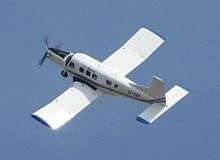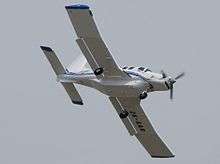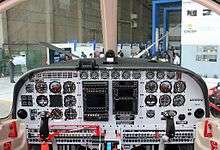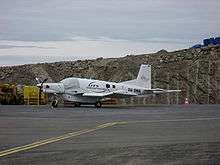PAC P-750 XSTOL
| P-750 XSTOL | |
|---|---|
 | |
| Role | Utility aircraft |
| National origin | New Zealand |
| Manufacturer | Pacific Aerospace |
| First flight | 2001 |
| Status | Active in production |
| Produced | 2001-present |
| Unit cost |
$US1.7-2.2 million[1] |
| Developed from | PAC Cresco |
The PAC P-750 XSTOL, (formerly known as the PAC 750XL) is a utility aircraft of conventional all-metal low-wing monoplane design, with fixed tricycle undercarriage. Combining the engine and wings of the PAC Cresco with a new large fuselage and modified tail, all versions to date have been powered by a 750 hp (560 kW) Pratt & Whitney Canada PT6 turboprop. It is designed and manufactured in Hamilton, New Zealand by Pacific Aerospace Limited.
Design and development
The design made its maiden flight in 2001. As with the Cresco, horizontal tail surfaces presented difficulties, and these were redesigned before the type entered production. The PAC 750 received full US FAA certification in 2004.
The type was targeted initially to the narrow market of skydiving. In the parachuting role, the high-lift wings from the Cresco and relatively high power-to-weight ratio enable the PAC 750 to take a load of parachutists to 12,000 feet (3,700 m) and return to land in 10 minutes.
A wider market was subsequently sought, and examples have been sold for use in utility roles, including freight, agricultural applications, passenger operations, aerial photography and surveying. Two aircraft have been extensively modified for geo-survey work, being fitted with a magnetic anomaly detector sting tail. Proposed ski and float conversions have yet to fly. The P-750 XSTOL is used in South Africa by NatureLink on United Nations Humanitarian Air Services / World Food Programme contracts. While the manufacturer claims lower single-engine running costs than many other utility types, for example, the twin-engined DHC-6 Twin Otter, the type has less usable volume (large cargo panniers providing a partial solution).
In 2008 the manufacturer stated production was increasing from 12 to 24 per year.[2] In 2008 there was some New Zealand media criticism of government assistance for the manufacturer following cancellation of a large order. By February 2016, 100 aircraft had been produced.[3]
The aircraft is currently marketed as the P-750 XSTOL. Pacific Aerospace offers the P-750 XSTOL in many configurations - passenger, freight/cargo, skydive, agricultural, aerial survey and surveillance. The aircraft is marketed as excelling on rough, unpaved airstrips and is available with a wide tyre modification for this purpose. The Defender II version is being developed for counter-insurgency and light attack.
For passenger and cargo operations, the cabin can be outfitted with up to nine passenger seats or with cargo holds. There is also an optional 1,000 lb capacity cargo pod available which attaches to the belly of the aircraft. The aircraft can be configured as all-passenger, all-cargo or a combination of both. All variants have double cargo doors at the rear of the cabin.
In 2012 Pacific Aerospace achieved certification for the P-750 XSTOL against ICAO Annex 6 for Single Engine IFR Commercial Passenger Transport Operations.[4]
Pacific Aerospace has allowed licence production in China.[5] A civil cargo PAC750XL UAV with minimal changes to enable remote piloting has been flown in China.[6]
In February 2016, the Papua New Guinea Defence Force signed an agreement to purchase four aircraft.[7]
In March 2018, Pacific Aerospace launched an updated variant, the Super-Pac XL, with a 900hp (670kW) PT6A-140A up from 750hp and a four-blade 108in (270cm) Hartzell propeller It competes with the Supervan 900 re-engined Cessna 208 Caravan with a 900hp Honeywell TPE331 and 110in four-blade Hartzell propeller. A modified P-750 is ground tested, and will begin flights for a second quarter of 2018 certification and later deliveries.[8]
To increase payload, a weight-reduction programme for 2020 replaces flight-control surfaces in aluminium by composite, installs lighter seating, and strips out cabin components. The passenger and utility aircraft markets account for 70% of its sales.[8]
North Korean appearance incident
A P-750 XSTOL in the markings of the North Korean state airline was photographed during the Wonsan Air Festival on September 24–25, 2016.[9] The aircraft had been sold to China in September 2017 and then illegally exported to North Korea. Pacific Aerospace expressed surprise, however New Zealand Customs discovered that even after the company was aware the aircraft was in North Korea some of the company staff had planned to sell replacement parts for the aircraft to a Chinese company. In October 2017 Pacific Aerospace plead guilty to three charges of planning to export aircraft parts indirectly to North Korea, and another charge relating to incorrect completion of export documentation.[10]
Specifications


Data from Pacific Aerospace[11]
General characteristics
- Crew: one (pilot)
- Capacity: Pilot + nine passengers or 17 parachutists [4]
- Length: 11.11 m (36 ft 5 in)
- Wingspan: 12.8 m (42 ft 0 in)
- Height: 3.88 m (12 ft 9 in)
- Wing area: 24.88 m2 (267.8 sq ft)
- Aspect ratio: 6.59
- Empty weight: 1,633 kg (3,600 lb)
- Gross weight: 3,402 kg (7,500 lb)
- Powerplant: 1 × Pratt & Whitney PT6A-34 turboprop, 560 kW (750 hp)
Performance
- Maximum speed: 315 km/h (196 mph; 170 kn)
- Cruise speed: 259 km/h (161 mph; 140 kn)
- Stall speed: 107 km/h (66 mph; 58 kn) Idle Power, Flaps Down
- Range: 2,183 km (1,356 mi; 1,179 nmi)
- Endurance: 8h
- Service ceiling: 6,096 m (20,000 ft)
- Rate of climb: 5.42 m/s (1,067 ft/min)
- Take-Off Ground Roll: 721 ft / 220 m (ISA, SL)
- Landing Ground Roll: 543 ft / 166 m (SL)
See also

Related development
Aircraft of comparable role, configuration and era
References
- ↑ "Kiwi aeroplane $120m deal takes off in China". National Business Review. November 12, 2014.
- ↑ "Power & punch to spare" (PDF). Australian Flying. March 2008. Archived from the original on 2009-02-03.
- ↑ David Donald (February 17, 2016). "100 Up for PAC-750". Aviation International News.
- 1 2 "P-750 XSTOL Description". Pacific Aerospace.
- ↑ "Pacific Aerospace Final Production Line in China". Flight Global.
- ↑ "China's AT-200 drone makes maiden flight". Xinhua. 27 Oct 2017.
- ↑ "PNGDF signs deal for six new aircrafts [sic]". Pacific Aerospace (Press release). 2 March 2016. Retrieved 12 March 2017.
- 1 2 Kate Sarsfield (14 March 2018). "Pacific Aerospace launches Super-Pac XL single-engined turboprop". Flightglobal.
- ↑ "How did North Korea get its hands on a New Zealand plane made with American parts?". Washington Post. 3 Oct 2016.
- ↑ "Pacific Aerospace guilty of planning unlawful export to North Korea". Stuff. 11 Oct 2017.
- ↑ "P-750 XSTOL specifications". Pacific Aerospace.
External links
| Wikimedia Commons has media related to: |
- Official website
- USA Distributor
- "Type Certificate Data Sheet" (PDF). European Aviation Safety Agency. 12 April 2006.
